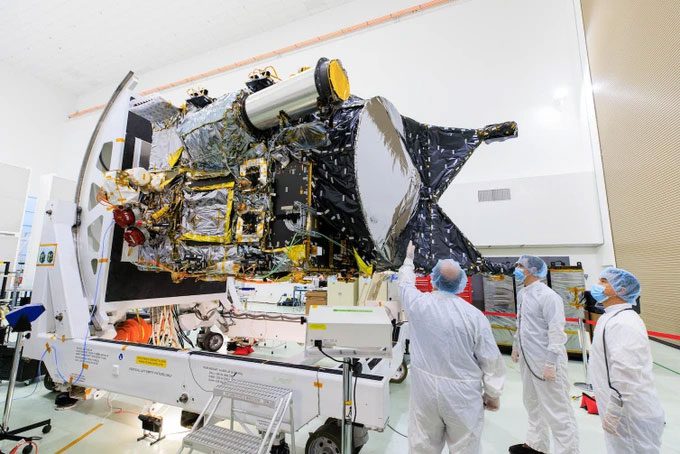The Psyche Mission is sending a spacecraft into space to indirectly study the Earth’s core, which may sound absurd, but it will be realized in the coming months.
In the 19th century, French novelist Jules Verne captivated readers worldwide with the idea of humans embarking on an exciting journey to the center of the Earth.

The Psyche asteroid will be the target of this mission. (Illustration: Sky & Telescope).
Since that proclamation, scientists have asserted that Verne’s literary journey was merely science fiction.
The temperature within the Earth’s core is approximately 5,537 degrees Celsius, extremely harsh, accompanied by a pressure environment millions of times greater than that on the Earth’s surface, making the exploration of the planet’s core an impossible task that few dare to contemplate.
However, scientists have discovered some aspects of the Earth’s interior, including that its core contains a solid ball of molten iron and nickel.
To achieve this, researchers have employed indirect methods by measuring the Earth’s magnetic field or seismic waves emanating from different layers beneath the surface.
This method still has certain limitations. So, how can cosmologists understand and explore deeper areas within our planet?
Of course, they cannot create a vehicle capable of penetrating the Earth’s core, so scientists devised a different, risky plan: to study the Earth’s core from outer space.
This task has been assigned to a NASA mission aimed at a metallic asteroid named Psyche.
Why Explore an Asteroid to Study the Earth’s Core?
Asteroids are considered small worlds by science, varying in size from that of a city to others that are large enough to be comparable to small countries.

Engineers are testing NASA’s Psyche spacecraft at a facility near Kennedy Space Center, Florida, before its launch into space. (Photo: NASA).
These asteroids are essentially debris created at the time the cosmos formed. Although most are rocky or icy, many are metallic and have compositions similar to that of the Earth’s core.
Thus, it’s fascinating to imagine that these metallic asteroids are remnants of the cores of planets that once existed, torn apart by ancient cosmic collisions.
This has sparked a bold idea among scientists: to study these asteroids to understand the Earth’s core.
Why the Psyche Asteroid?
Psyche is the largest metallic asteroid known to humanity, discovered in 1852, with a width comparable to that of the state of Massachusetts in the United States.
Psyche resides in the asteroid belt located between Mars and Jupiter, approximately 750 million kilometers from Earth.
This region contains billions, even trillions, of asteroids. Most of these asteroids are relatively small, ranging in size from a boulder to several kilometers in diameter. However, some asteroids are significantly larger.
In early 2017, the National Aeronautics and Space Administration (NASA) approved a $1 billion mission named Psyche, which is scheduled to launch into space in October 2023 aboard a SpaceX rocket.
The spacecraft is expected to reach the asteroid in October 2029. Subsequently, it will spend 26 months operating on the asteroid to map its geology, topography, gravity, and magnetic field.
The data collected from the spacecraft will be sent back to Earth for scientists to compare its composition with what they know or have predicted about the Earth’s core.
However, many scientists are questioning whether Psyche is indeed a remnant core of a planet in space, or simply a large rock or something entirely different that remains unknown to us.
Moreover, is the scientific understanding of Psyche accurate enough to extrapolate in resolving some mysteries about the Earth’s core? So far, no cosmologist has dared to make such a claim.
But even if we find out that Psyche is not an ancient planetary core, this still provides an opportunity for humanity to enhance its knowledge about the Solar System and how planets form.
After all, Psyche is unlike any world humanity has ever visited. Perhaps we may not be able to undertake a journey to the center of the Earth, but the presence of spacecraft in places like Psyche could help unlock the mysteries deep within planets, including our own.
In August 2023, the SpaceX Falcon Heavy rocket will launch the Psyche spacecraft from Earth. The remainder of the journey will depend on the ion propulsion system equipped on the spacecraft to propel it out of the Solar System, with the Psyche spacecraft expected to take about six years to reach the asteroid.
Throughout the journey, the Psyche team, the scientists supporting the mission at NASA’s Jet Propulsion Laboratory in Pasadena, California, and scientists from Arizona State University will maintain regular communication with the spacecraft using NASA’s Deep Space Network to send and receive data.


















































